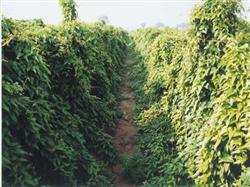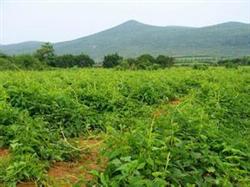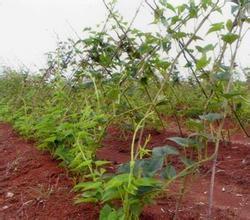Key points of cultivation techniques of Yam (Dioscorea zingiberensis)

Variety selection at present, the main varieties of yam are fine-haired yam, Ermao yam and Japanese "Daiwa taro" yam. Both fine-haired yam and Ermao yam belong to the variety of common yam. Japanese yam is a variety with strong adaptability, good quality, strong disease resistance, high yield and promising development. Peng Juntian is the yam variety of Japanese "Daiwa taro". The cultivation of selected land and ditch and whole border yam should avoid continuous cropping as far as possible, generally rotate every three years, and avoid planting peanut and red taro stubble. It is better to choose the land with deep, loose and fertile soil layer, and the upper and lower soil quality is required to be the same. if there are heavy clay layer and white sand hill soil layer in the lower layer, it should be broken thoroughly when digging ditches, and there can be no clay, soil sand and other interlayers in the soil layer of at least 1-1.2 meters. Otherwise, it will affect the appearance and quality of tubers. The soil should be neutral. At present, mechanical ditching is generally used in ditching. It is suitable for yam cultivation in the north-south direction, double-row planting or single-row planting (you can widen the row spacing according to the needs of individual plots). When double-row planting, the large row spacing is 1.7 to 1.8 meters, the small row spacing (the row spacing of the two yams in the ditch) is 40 cm, the plant spacing is 20 cm 25 cm, the ditch depth is 85 cm 100 cm, and the ditch width is 70 cm. The land should be leveled when preparing the land to prevent uneven watering. Drainage design should also be done to ensure that there is no stagnant water in the field. When planting in a single row, the row spacing is 80cm 100cm, the groove width is 30cm, the groove depth is 90cm 100cm, and the plant spacing is 20cm 25cm. The suitable time for sowing greenhouse yam is generally planted around New Year's Day, and the ground temperature of 5 cm is generally required to be more than 9: 10 ℃. Dry the yam seedlings before sowing, which can not only activate the seed potato, but also play the role of sterilization and high budding rate. If the yam stem is cut off to make a seed potato, it can be stained with lime powder in time at the cut to play a role in disinfection. When sowing, it is necessary to soak the seeds under a piece with buds and a piece of average size, so that the buds will come out evenly. In addition, soak the seeds with 1000 times of carbendazim, 1000 times of strychnine and 72% chlorothalonil for 3 minutes. After drying, you can sow seeds and spray new high-fat film on the surface of seeds before sowing. Chinese yam is mainly composed of organic fertilizer (such as rotten cake fertilizer, chicken manure, duck manure or human and animal manure, etc.), supplemented by inorganic fertilizer. Generally, 2000kg / mu can be applied, plus 40kg / mu of high-potassium compound fertilizer, or 200kg / 300kg of special bio-organic fertilizer for yam, which is fully mixed with the soil to prevent seedling burning. Field management 1. Shallow topdressing. If the basal fertilizer is applied more, there is less topdressing or no topdressing. In order to ensure the high yield of Chinese yam, it is generally applied 2-3 times, once when the plant grows to about 1 meter, and then once every other week or so, three times. During the expansion period of Chinese yam, the multi-element compound fertilizer with high content of phosphorus and potassium is mainly used (the demand ratio of nitrogen, phosphorus and potassium of Chinese yam is 1.5 (2)), about 30 kilograms per mu, it is best to adopt the method of flushing application. In the later stage of growth, 0.2% potassium dihydrogen phosphate and 1% urea can be sprayed on the leaves to prevent premature senility. In particular, it should be noted that the root system of Chinese yam is distributed shallowly, occurs early and extends horizontally, so it should be applied into the shallow soil layer for Chinese yam root absorption. 2. Keep a firm grip. Insert frame and herbicide yam after sowing, cover with 6cm floating soil, spray 100kg water evenly with "special Chinese yam herbicide" 150kg 200g, then cover plastic film and set up a frame in time after emergence, the frame is about 2 meters high, the front is "human" shape, the side is oblique crossing, and reinforced with thick bamboo pole or wooden stick every 7 to 8 meters, in short, it must be firmly set up to prevent tilting. 3. Watering skillfully. Chinese yam should not be too dry for fear of waterlogging. If it is too dry, it will seriously affect the expansion of yam, especially in the period of tuber expansion, which is from mid-April to late May, which is usually watered once every 10 days. After late May, watering should be properly watered according to soil moisture. 4. Keep up with the prevention and control of diseases and insect pests. The incidence of diseases and insect pests was more serious in the continuous cropping land, and the incidence of the land planted in the first year was lighter. After the yam vine was put on the shelf, spraying control began. The main disease of Chinese yam is anthracnose, which is a fungal disease, which is called deciduous disease, which shows that the leaves turn yellow at the initial stage, there are small spots on the leaves, and finally the stem and withered leaves fall, the disease is mainly prevented, the crop rotation is done, and the disease-free seed potato is selected. seed potato was disinfected by soaking seeds with 25% carbendazim powder 500 times for 30 minutes before sowing, and field management was strengthened after cultivation to enhance plant disease resistance. Generally, 70% mancozeb 500 times 600 times and 50% methyl topiramate 700 times 800 times can be alternately sprayed at the initial stage of the disease. Japanese "Daiwa taro" yam special formula pesticides can be used when the disease is serious, and spray is carried out every 7 to 10 days at the initial stage of the disease. generally, it can be sprayed 2 times in a row for 3 times. The harvest period of normal open-field yam is very long. From August 20 to April and May of the following year, the yam does not rot or deteriorate underground. Generally, there is a concentrated harvest period before and after Frosts Descent for the Spring Festival market. But the greenhouse yam is different, because the harvest time is about June 20, the yam itself has low starch content and high water content, so it can not be stored for a long time. The greenhouse yam should be sold in time after harvest. In addition, due to the planting scale and other factors, the greenhouse yam is now mostly excavated manually, because the yam skin is very thin, it is necessary to prevent mechanical damage when digging yam, and the yam is piled with mud and foreskin for sale. Or the first kind: it is suitable to grow in the cave tube. In addition to hole tube cultivation, reasonable fertilization or complete application of mature organic fertilizer can improve the yield and quality of Chinese yam. Organic fertilizers can improve soil composition, provide adequate nutrients, prolong the time for the release and utilization of nutrients, improve root respiration, and provide sufficient water. The nutrients of the newly budded yam plants come from the mother potato, and the yam at the early stage of development needs more nitrogen fertilizer to promote its growth, and potash fertilizer is particularly important at the beginning of potato formation. Chinese yam seems to be easy to absorb phosphate fertilizer from the soil, in addition, if magnesium fertilizer can be added, it will also help to increase yield. The second kind: cultivated yam (Dioscorea zingiberensis), we must choose the sandy soil with fertile soil, deep soil layer, strong water and fertility conservation, good ventilation and convenient drainage and irrigation. When turning the land deeply, we should first turn the topsoil layer of 20 cm to 30 cm above to one side, and then continue to turn to 35 cm to 45 cm. Do not upset the soil layer. After the land is turned deep, a cultivation ditch is formed, and the base fertilizer can be applied into the cultivation ditch. Basic fertilizer generally applies 20 kg of calcium superphosphate, 3000 kg of mature organic fertilizer and 200 kg of plant ash per mu. When fertilizing, you can first fill the bottom of the planting ditch with the original topsoil, the thickness is 15 cm, and then apply the base fertilizer on the soil layer, and finally cover the soil 15 cm. The topdressing of Chinese yam is mainly in the middle and later stage of growth, and less fertilizer is needed in the early stage. After the Chinese yam emerges neatly, 20% human feces and urine fertilizer is applied once, and then every 20-30 days. Fertilization can dig a 6-10 cm deep fertilizer ditch 30 cm away from the plant, and apply 700-1000 kg of human feces and urine per mu. When the underground tuber enters the vigorous growth period, topdressing should be applied again. Compound fertilizer 20kg / mu and cake fertilizer 40kg / mu were applied in holes or furrows, and soil was covered after fertilization to ensure that there were sufficient nutrients for tuber elongation and expansion. Later, according to the growth of the plant, we will determine whether to topdressing or not.
- Prev

Standardized production technology of yam
I. Environmental conditions Yam planting has strict requirements on soil. Generally, it should be planted in loam or sandy loam plots with deep soil layer, loose soil and no roots, stones and rubble in the soil layer 1 meter below the surface. Clay fields can also be planted, but will reduce the commercial nature of yams and difficult to harvest. Second, cultivation...
- Next

A New method for High yield of Chinese Yam
1. Shallow topdressing and skillful watering: when fertilizing, shallow soil layer should be applied for root absorption of yam, shallow topdressing or less topdressing can ensure high yield of Chinese yam, Chinese yam should not be too dry for fear of waterlogging, if too drought will seriously affect the expansion of yam, spraying new high-fat film reasonably matches the distribution of water and fertilizer. 2, the frame should be firm: set up the frame in time after emergence.
Related
- Where is it suitable to grow horseradish in China? it is expected to see the middle altitude horseradish in Alishan.
- How to prevent tomato virus disease reasonably? (Control methods included)
- Many people like to plant towel gourd on the balcony. What are the main points of this method and management?
- What crops can chili peppers be mixed with?
- Fertilization techniques and matters needing attention in Tomato
- What are the grafting techniques for peach seedlings in spring?
- Harm and control methods of root swelling disease of Chinese cabbage
- What are the pests of sweet potatoes? How to prevent and cure it?
- Symptoms, causes and Control methods of navel Rot in Tomato
- The cause of "Cucumber rotten bibcock" in Farmers' planting Cucumber and its Control Plan

